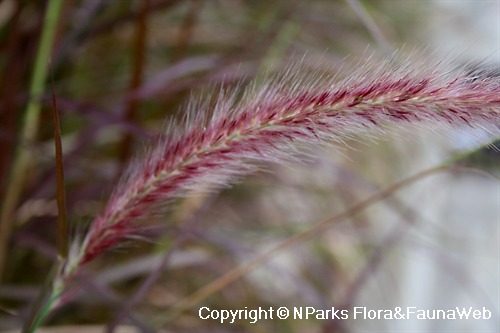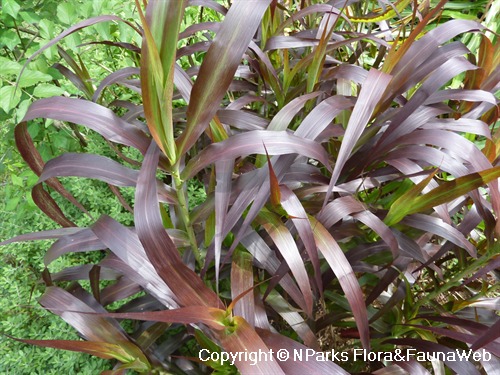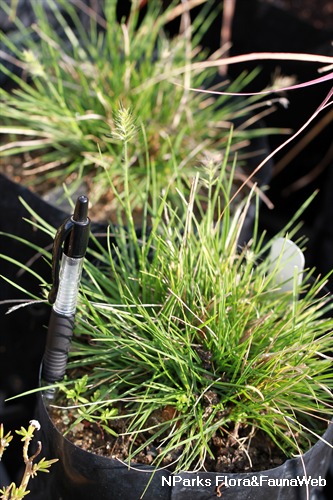
Back
Cenchrus × cupreus 'Rubrum'
| Family Name: | Poaceae (Gramineae) |
| Synonyms: | Pennisetum × advena 'Cupreum', Pennisetum × advena 'Atropurpureum', Pennisetum × advena 'Purpureum', Pennisetum × advena 'Rubrum' |
| Common Name: | Purple Fountain Grass, Red Fountain Grass, Rose Fountain Grass |
Name
Classifications and Characteristics
| Plant Division | Angiosperms (Flowering Seed Plants) (Monocotyledon) |
|---|---|
| Plant Growth Form | Grass or Grass-like Plant (Tall Grass (Poaceae)) |
| Lifespan (in Singapore) | Perennial |
| Mode of Nutrition | Autotrophic |
| Plant Shape | Irregular |
| Maximum Height | 1.2 m to 1.5 m |
| Maximum Plant Spread / Crown Width | 0.5 m to 1.2 m |
Biogeography
| Native Distribution | Central Africa |
|---|---|
| Native Habitat | Terrestrial (Grassland / Savannah/ Scrubland) |
| Preferred Climate Zone | Sub-Tropical / Monsoonal |
Description and Ethnobotany
| Growth Form | This hybrid forms upright clumps up to 1.5 m tall. |
|---|---|
| Foliage | Narrow, linear leaves are red-burgundy and usually less than 2 cm wide. |
| Flowers | The inflorescence is shaped like a bushy tail and may be more than 0.3 m long. |
| Fruit | This cultivar seldom sets seed. |
| Others - Plant Morphology | In the nursery trade, this cultivar is often mistakenly referred to as Pennisetum setaceum 'Rubrum'. |
| Taxonomy | Grass taxonomist J. K. Wipff determined that this cultivar is a hybrid between Pennisetum macrostachyum and Pennisetum setaceum based on breeding experiments. |
| Ethnobotanical Uses | Others: Young inflorescences and infructescences may be cut and used in floral arrangements. Older infructescences tend to fall apart when dried. |
Landscaping Features
| Desirable Plant Features | Ornamental Flowers, Ornamental Foliage |
|---|---|
| Landscape Uses | Container Planting, Coastal, General, Suitable for Rooftops, Vertical Greenery / Green Wall, Flowerbed / Border, Focal Plant |
| Thematic Landscaping | Naturalistic Garden, Formal Garden, Wildflower Garden |
| Plant & Rootzone Preference or Tolerance Remarks | Prefers soil pH of 6.6 - 7.5. |
Fauna, Pollination and Dispersal
| Fauna Pollination Dispersal Associated Fauna | Bird-Attracting (Scaly-breasted Munia (Lonchura punctulata was observed to feed on its seeds in Singapore (Bird Ecology Study Group blog, 2013)., Seeds) |
|---|---|
| Pollination Method(s) | Abiotic (Wind) |
| Seed or Spore Dispersal | Abiotic |
Plant Care and Propagation
| Light Preference | Full Sun |
|---|---|
| Water Preference | Moderate Water |
| Plant Growth Rate | Moderate |
| Rootzone Tolerance | Fertile Loamy Soils, Well-Drained Soils, Saline Soils / Salt Spray, Easy to Grow, Drought Tolerant, Polluted Air |
| Diseases | Rust, Eye spot, Leaf spots |
| Propagation Method | Division |
| Propagule Establishment Remarks | Seeds reported to be sterile. Divide clump every 2-3 years. |
| Maintenance Requirements Remarks | Leaves tend to flop over during heavy rain or when hosed with water. For neat appearance, remove old foliage before new leaves emerge. |
Foliar
| Foliage Retention | Evergreen |
|---|---|
| Mature Foliage Colour(s) | Purple, Red |
| Mature Foliage Texture(s) | Smooth, Thin |
| Foliar Type | Simple / Unifoliate |
| Foliar Shape(s) | Non-Palm Foliage (Linear) |
| Foliar Venation | Parallel |
| Foliar Margin | Entire |
| Foliar Apex - Tip | Acuminate |
| Typical Foliar Area | Macrophyll ( 182.25cm2 - 1640.25 cm2 ) |
| Leaf Area Index (LAI) for Green Plot Ratio | 3.5 (Shrub & Groundcover - Monocot) |
| Mature Foliage Colour(s) Remarks | Red-Burgundy |
Non - Foliar and Storage
| Stem Type & Modification | Acaulescent |
|---|---|
| Root Type | Underground (Fibrous Root) |
Floral (Angiosperm)
| Flower & Plant Sexuality | Bisexual Flowers |
| Flower Colour(s) | Purple, Red |
|---|---|
| Flower Texture(s) | Hairy / Hirsute |
| Flower Grouping | Cluster / Inflorescence |
| Flower Location | Terminal |
| Inflorescence Type | Spike |
| Flowering Period | Free-Flowering |
| Flowering Habit | Polycarpic |
| Inflorescence Size Remarks | Flower plumes mature from reddish to sandy brown. |
Fruit, Seed and Spore
| Mature Fruit Colour(s) | Purple |
|---|---|
| Fruit Classification | Simple Fruit |
| Fruit Type | Indehiscent Dry Fruit , Caryopsis / Grain |
References
| References | Darke, Rick. 2007. The Encyclopedia of Grasses for Livable Landscapes. USA: Timber Press. 487pp. |
|---|
Image Repository
Others
| Master ID | 1020 |
|---|---|
| Species ID | 2314 |
| Flora Disclaimer | The information in this website has been compiled from reliable sources, such as reference works on medicinal plants. It is not a substitute for medical advice or treatment and NParks does not purport to provide any medical advice. Readers should always consult his/her physician before using or consuming a plant for medicinal purposes. |












